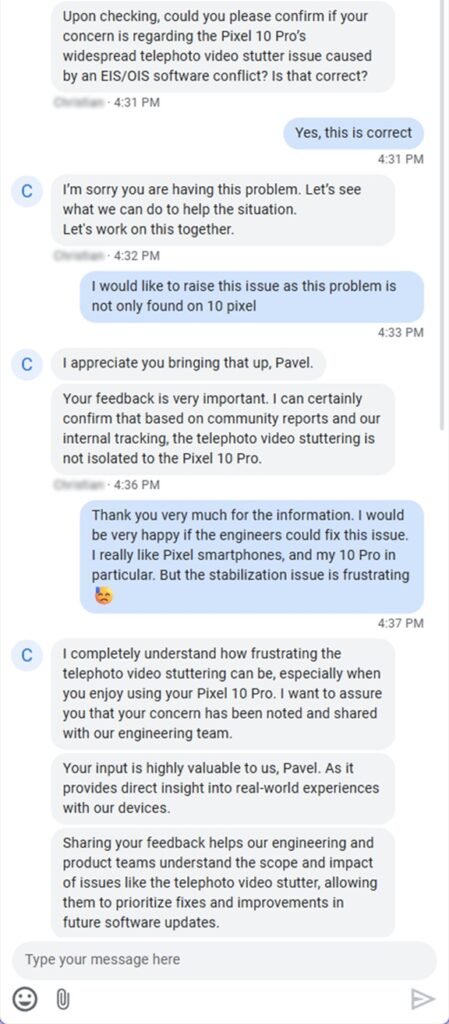For months, Pixel users have been dissecting a strange but repeatable flaw that undermines one of Google’s biggest selling points: video stabilization. What began as a curious stutter when panning on the Pixel 10 Pro’s 5x telephoto lens has now escalated into a full-blown saga. And the latest update suggests Google may have quietly walked away from fixing it altogether.
How we got here
The issue first came to light when a Pixel 10 Pro owner documented severe stuttering whenever panning video using the telephoto lens with Electronic Image Stabilization (EIS) enabled. Testing quickly revealed a clear pattern: with EIS on, the footage exhibited sharp, unnatural jumps. Turn EIS off and rely only on Optical Image Stabilization (OIS), and the problem disappeared.
Further community testing confirmed something more troubling. This wasn’t limited to a single device or even the Pixel 10 Pro alone. Similar behavior was observed across multiple Pixel generations, indicating a systemic software-level problem rather than a hardware defect.
Google support later acknowledged that the stutter stemmed from a conflict between EIS and OIS, even noting that the problem was not isolated to one model. That admission initially raised hopes that a software fix was finally on the way.

The promised fix that changed nothing
Those hopes peaked when Google indicated the issue had been addressed in upcoming Pixel Camera updates. The rollout included versions 10.1.076.816441313.17 and later 10.1.076.821848723.18, which arrived via the Play Store.
However, detailed post-update testing told a different story. The telephoto stutter remained unchanged, with side-by-side comparisons again showing that third-party apps like Open Camera, which rely on their own stabilization APIs, continued to deliver smooth footage while Google’s native app struggled.
The only tangible improvement from these updates was unrelated: ProRes 50MP mode was unlocked, expanding zoom capabilities from 30x to 100x and improving image quality. While welcome, it did nothing to resolve the stabilization conflict that triggered the original complaints.
Community data vs Google’s final stance
Frustrated but persistent, the original investigator went further, compiling logs, video comparisons, and reports from other Pixel Pro users across the 10, 9, 8, 7, and 6 series. The findings were consistent: the EIS-induced stutter persisted even after the so-called fix.
This extensive report was submitted back to Google support as evidence that the patch had failed. After weeks of silence, the response arrived, but it wasn’t encouraging. Google reportedly reframed the matter as a “specific issue” and stated it could not promise a fix, effectively signaling that no concrete resolution is currently planned.

In practical terms, this marks the closest thing yet to an official abandonment of the bug, despite the mountain of community data suggesting it’s widespread and reproducible. But it’s worth noting that information shared by customer support should be taken with a grain of salt. Support agents don’t always have access to up-to-date information and, in some cases, even share misleading information. That said, it’s still coming from Google technically, which makes it hard to ignore.
Disabling EIS or relying on third-party camera apps remains the only reliable workaround. However, for a device marketed as a premium, “Pro” camera phone, this is a hard pill to swallow. Hybrid stabilization is essential for active video scenarios, and asking users to juggle settings or resort to external apps undermines the seamless experience Google prides itself on.
The situation also highlights an uncomfortable contradiction: while third-party developer documentation warns about potential OIS/EIS conflicts, Google’s own camera app enforces this broken combination without offering an effective fix or user-facing guidance.
A loyalty test for Pixel fans
Perhaps the most striking element of this saga is the tone of the broader community response. Many affected users, including the original investigator, remain loyal to the Pixel ecosystem, citing its clean UI, compact design, and AI features as reasons they want the device to succeed. Yet the comparison with competitors like Samsung’s latest Ultra models, which deliver smooth hybrid stabilization, only sharpens the frustration.
For now, the Pixel 10 Pro telephoto stutter stands as a sobering reminder that even Google’s celebrated computational photography can falter. And when it does, software alone isn’t always the easy savior it promises to be.
Unless Google reverses course and revisits this issue in future Pixel Camera updates, one of the platform’s most persistent video bugs may remain unresolved, leaving flagship users with little more than workarounds and unanswered questions.
Editor’s note: The article has been slightly modified in parts, including the headline, to reflect that the information shared was from Google’s support team, which doesn’t necessarily make it the company’s official stance.


